Identifying Real and Fake Diamonds: A Comprehensive Guide
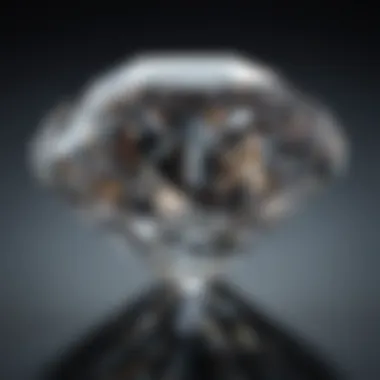
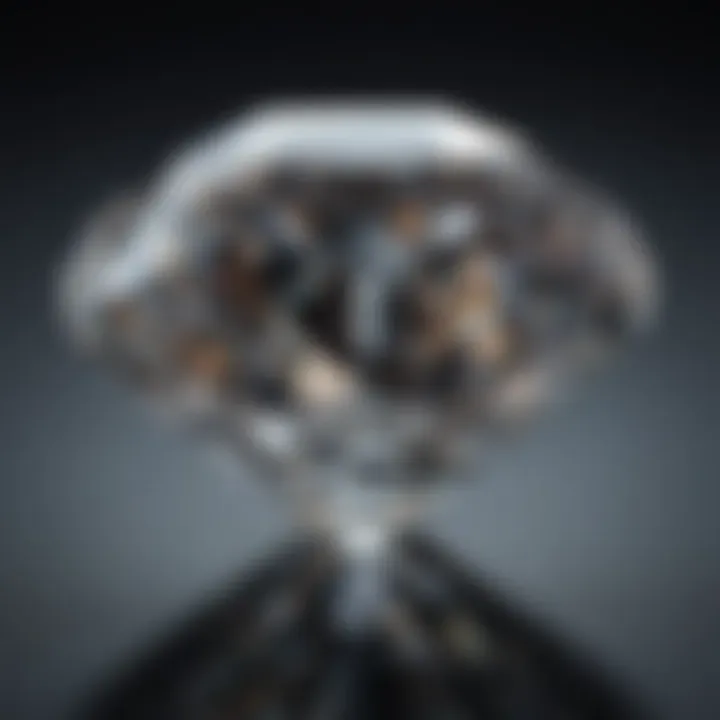
Intro
Determining the authenticity of diamonds is no small feat. The world of gemstones is filled with intricacies that demand attention to detail. For enthusiasts and buyers alike, understanding the factors that differentiate real diamonds from imitations is a journey that combines both knowledge and practical skills. In this guide, we will equip you with the essential insights needed to navigate the often murky waters of diamond identification, ensuring that each gemstone you encounter is assessed accurately.
Please note, while it may be enticing to rely solely on a salesperson's word when purchasing diamonds, a deeper understanding of the various indicators of authenticity can prevent missteps that might lead to costly mistakes.
Gemstone Overview
Definition of Gemstones
Gemstones are not just simplistic representations of beauty; they are nature’s marvels, formed over millions of years under specific conditions. At their core, gemstones are minerals, rocks, or organic materials that possess qualities that make them desirable, such as peculiar colors or exceptional clarity. They often undergo various processes before they can be rightly termed as gems—these can include cutting, polishing, and sometimes treatments to enhance their appearance.
Classification of Gemstones
Gemstones, including diamonds, can generally be classified into two categories: precious and semi-precious.
- Precious gemstones are rare and include diamonds, emeralds, sapphires, and rubies. Their value is elevated due to their beauty and rarity.
- Semi-precious gemstones, on the other hand, include a range of stones like amethysts, garnets, and peridots. While they may still possess beauty, they are found more abundantly than their precious counterparts.
It's important to also recognize that diamonds, while classified as precious, come in various forms and qualities, each playing a significant role in their overall value and authenticity.
Historical Significance
Origins of Gemstone Use
The allure of gemstones is far from a modern phenomenon. Throughout history, cultures have adorned themselves with these captivating stones, attributing various meanings and powers to them. From ancient civilizations to contemporary gemology, diamonds and their counterparts find their origins steeped in tradition and mystique. The earliest known use of diamonds dates back to the first century, where they were considered not only jewelry pieces but also talismans believed to provide protection.
Cultural Insights: Gemstones in Ancient Civilizations
Different cultures uniquely approach gemstone usage, often shaped by historical, economic, and spiritual factors. For instance, in Ancient India, diamonds were thought to provide courage and invincibility to warriors, while in Ancient Egypt, they were intertwined with the beliefs about the afterlife.
Understanding these historical contexts not only enriches one’s appreciation of gemstones but also lends perspective in identifying their authenticity, as many fakes are designed to exploit the age-old appeal of these magnificent stones.
"As we uncover the layers of history enveloping diamonds, we not only educate ourselves but also build a more discerning eye for authenticity."
Recognizing both the practical mechanics of diamond identification and the rich history surrounding these gemstones can provide you with a robust foundation for making informed purchasing decisions.
Understanding Diamonds
Diamonds have long captivated the hearts and minds of people worldwide. Their allure lies not just in their remarkable beauty, but also in their complex formation process and the differentiation between natural and synthetic varieties. Grasping the fundamentals of diamonds is crucial for anyone interested in making informed decisions, whether for investment or personal enjoyment.
The Formation of Natural Diamonds
Natural diamonds are born under extreme conditions deep within the Earth. This process can take millions, sometimes even billions of years. Formed about 100 miles below the surface, carbon atoms undergo a transformation at high pressure and temperature, resulting in the precious stones we are familiar with today. As the geological activity pushes these gems closer to the crust, they are brought to the surface by volcanic eruptions.
To underline this point:
"Diamonds are like nature’s enduring trophies; they symbolize both time and resilience."
Understanding the formation of natural diamonds gives insight into their value. Unlike synthetic diamonds, which can be produced in laboratories in a matter of weeks, natural diamonds carry a rich history and rarity that significantly impacts their worth. Many mistake the origins of diamonds, thinking all are created equal—this assumption can easily lead to misidentification.
Synthetic vs. Natural Diamonds
The conversation around synthetic vs. natural diamonds has gained momentum in recent years. Synthetic diamonds, also known as lab-grown or created diamonds, are chemically identical to their natural counterparts. However, they differ in terms of origin. Natural diamonds are products of earth’s geological processes, while synthetic ones are made using human technology.
In today’s market, synthetic diamonds can be produced using two primary methods:
- High Pressure-High Temperature (HPHT): Mimics the conditions under which natural diamonds form.
- Chemical Vapor Deposition (CVD): A more modern approach that involves gases that crystallize into diamond form.
While both types of diamonds can exhibit striking beauty, their perception differs. Many feel that natural diamonds hold intrinsic value because of their natural formation process. Conversely, others opt for synthetic ones due to price and ethical considerations.
Ultimately, discerning the differences between these two types unveils deeper insights into each stone's significance. Relying on information and knowledge about diamonds helps buyers navigate the intricate gemstone market.
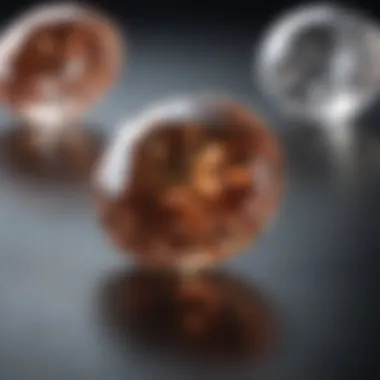
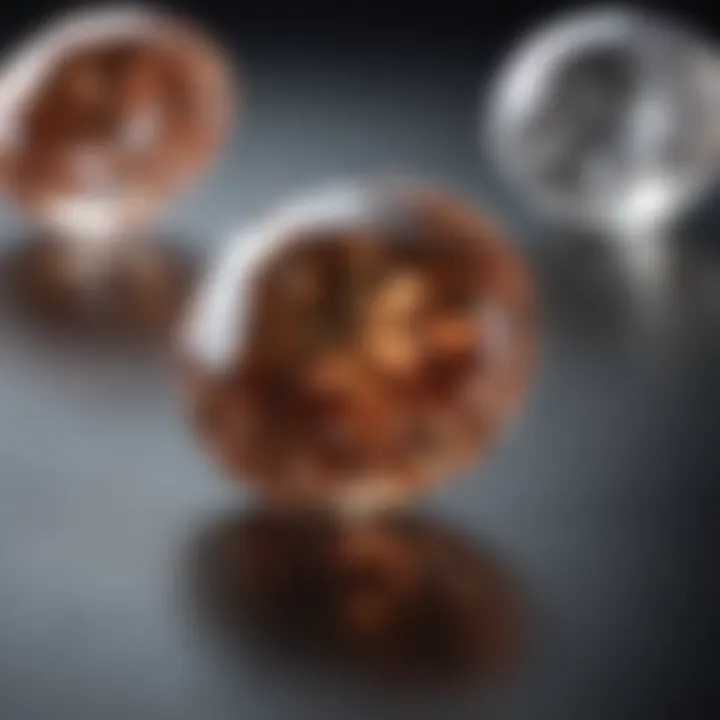
Visual Characteristics of Real Diamonds
Identifying real diamonds hinges significantly on their visual characteristics. These traits not only provide the first impression of a diamond but also reveal critical details that can determine its quality and authenticity. Each visual element — from sparkle to clarity — helps distinguish genuine diamonds from lesser imitations. Understanding these characteristics enables enthusiasts, collectors, and buyers to make informed decisions in a marketplace populated by both authenticity and deception. Digging deep into the visual aspects fosters the knowledge necessary to recognize a diamond’s singular beauty while ensuring that the investment made is well worth it.
Brilliance and Fire
When we talk about brilliance in diamonds, we refer to the way light interacts with the gemstone. A well-cut diamond is like a finely-tuned musical instrument; it reflects light beautifully, creating a mesmerizing effect that captivates the eye. The term "fire" describes the rainbow-like flashes of color produced when light enters and exits the stone.
Each diamond differs in its ability to capture these effects based on its cut, which dramatically influences its brilliance and fire. A round brilliant cut, for example, tends to exhibit superior brilliance because it maximizes the amount of light returned to the observer. This reflects the skill of the cutter in optimizing the stone’s structure to enhance light performance.
Important to Remember: A diamond’s brilliance and fire can be diminished by a poor cut, making evaluation of cut quality paramount in identifying true diamonds.
Clarity and Cut Evaluation
Clarity refers to the presence of any inclusions or blemishes within a diamond. While eye-clean stones are preferred, minor imperfections are common, especially in natural diamonds. Evaluating clarity involves scrutinizing a diamond under magnification. The GIA (Gemological Institute of America) grading system categorizes clarity from Flawless (no inclusions visible) to Included (inclusions visible to the naked eye).
The cut of a diamond is equally crucial since it dictates not just its appearance but performance. Various cuts, such as princess, oval, or cushion, affect how a diamond interacts with light. Evaluating cut quality encompasses looking at the angles and proportions of the diamond, which ultimately impacts its brilliance. Thus, familiarity with cut grading helps enthusiasts discern whether a diamond is genuine or not, especially when imitations attempt to mimic these characteristics.
Color Grading Systems
Diamonds come in a spectrum of colors, and their grading is an essential part of visual assessment. The color grading scale typically ranges from D (colorless) to Z (light yellow or brown). The less color a diamond has, the higher its value; however, some buyers may desire fancy colored diamonds intentionally, which brings other grading considerations.
The process of color grading involves comparing the diamond to a set of master stones under controlled lighting conditions. Trained gemologists ensure consistency and accuracy in this process. Being aware of this system helps buyers identify genuine diamonds while being cautious of stones that may appear more colorful than they actually are, particularly if they are of lower quality.
Ultimately, understanding these visual characteristics not only enriches the experience but also empowers buyers with the knowledge to navigate the often murky waters of diamond authenticity.
Practical Tests for Authenticity
When it comes to identifying whether a diamond is authentic or a clever imitation, practical tests hold a vital place in the assessment process. These tests, unlike theoretical discussions or visual inspections, offer tangible means to confirm a diamond's authenticity. They underscore the need for diligence and can often be performed without the need for professional tools. However, it is essential to approach these tests with a discerning eye, noting that while they can be very effective, results should be interpreted within the broader context of the gem's overall characteristics.
Several benefits arise from conducting practical tests:
- They are generally low-cost and accessible to most individuals.
- Many of these tests require minimal equipment, allowing for impromptu evaluations.
- They can provide immediate results, saving time compared to sending a jewel to a lab.
However, one must keep in mind that practical tests are not infallible. Misinterpretation of results may lead to errors in judgment. Thus, knowledge of how and when to use these tests is crucial for ensuring a comprehensive appraisal of the stone in question.
The Water Test
The water test is one of the simplest ways to check if your diamond is genuine. The concept is straightforward: drop the stone into a glass of water and observe how it behaves. Real diamonds have a high density, so they won’t float; they should sink immediately. In contrast, most imitation diamonds, particularly those made from materials like glass, tend to float or linger near the surface.
Several factors should be kept in mind:
- Ensure that the glass of water is deep enough; this avoids floating due to surface tension.
- Always consider the specific gravity of the gem in question; not all gemstones will sink.
- This test is not a definitive proof but rather a preliminary check.
Fog Test Analysis
Another practical method to distinguish real diamonds from their counterparts is the fog test. To execute this test, take the diamond and breathe on it lightly; the idea is to create a fog on the surface. Real diamonds disperse heat rapidly, meaning any fog will clear up almost instantly, often within a second or two. Conversely, imitation stones or less genuine diamonds retain the fog for several seconds, indicating they do not disperse heat as effectively.
This test is straightforward and can be done almost anywhere:
- Ensure your breath isn't excessively warm; chilly air gives clearer results.
- Consider that humidity or natural moisture can affect performance — use a clean, dry setting.
- This test is more effective alongside other methods to form a rounded conclusion about authenticity.
Heat Conductivity Test
The heat conductivity test delves into a diamond's fundamental physical properties. Natural diamonds conduct heat better than almost any other gemstone. A simple way to test that is by using a thermal diamond tester, which can be found at many gemology shops or online where you can buy quality testing tools.
How it works:
- Place the tip of the tester against the surface of the diamond, and an immediate reading will display conductivity.
- Real diamonds should show up as very high, while other stones fail to reach that same level.
However, note that having a thermal tester can raise some costs. On occasion, synthetic diamond variants may also conduct heat similarly; thus, combining this test with others is best for verified results.
Scratch Test Considerations
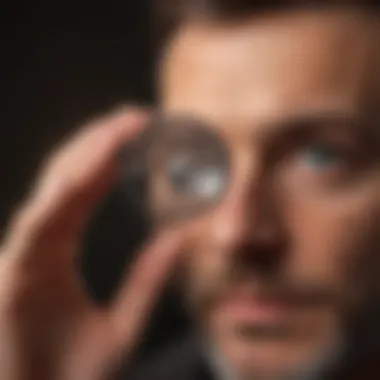
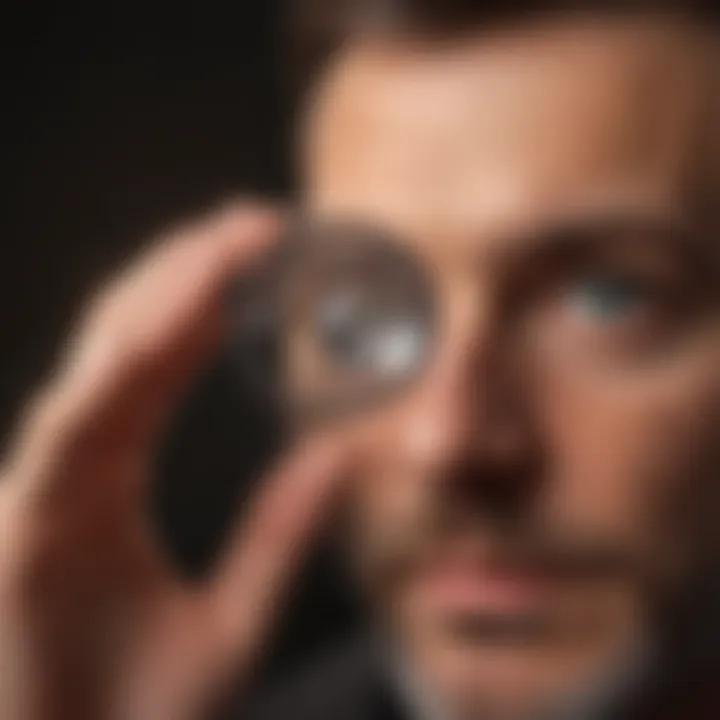
The scratch test is a controversial method because it involves potentially damaging the stone being tested. Nevertheless, it can be useful if done carefully. Real diamonds are the hardest known natural materials and can scratch nearly anything else, except for other diamonds.
When considering a scratch test:
- Use a known quartz or glass surface as a comparative measure.
- Lightly scratch the stone in a discreet area; this can minimize the risk of visible damage.
- If your diamond creates a mark on softer materials, it’s not likely genuine. However, be cautious — several gemstones can be similarly hard.
Experimenting with these various practical tests can provide key insights, but exercise caution throughout. Each method holds strength but must be considered part of a broader investigation into the gemstone's authenticity.
Advanced Techniques for Diamond Verification
When it comes to ensuring the authenticity of diamonds, basic visual tests and personal assessments can only carry one so far. For serious gemstone enthusiasts, understanding advanced techniques for diamond verification is paramount. These methods offer precision and peace of mind, ensuring that what you have is, in fact, the real McCoy. From utilizing professional services to scientific reports and magnification tools, these approaches illuminate the true nature of a diamond beyond mere surface appearances.
Professional Appraisal Services
Using a professional appraisal service can be crucial when it comes to verifying a diamond’s authenticity. Unlike a casual examination at a jewelry store, these specialists are trained professionals who provide a meticulous evaluation based on a refined set of criteria. They assess not only the stone's visual attributes but also its origin and market value. Here are some key points regarding professional appraisals:
- Credentials Matter: It’s vital to engage appraisers with proper credentials, like certifications from renowned institutions.
- Detailed Documentation: A professional appraisal includes all essential details, offering documentation that certifies the diamond's properties.
- Second Opinion: A reputable appraiser can also offer a second perspective, which can help reinforce or challenge initial findings from other tests.
Gemological Laboratory Reports
Gemological laboratories play an indispensable role in diamond verification. These labs utilize advanced technology to analyze diamonds with accuracy. Their reports are often considered the gold standard in the industry. An official laboratory report typically includes:
- Certification number: Unique identifier for each diamond.
- Grading information: Detailed notes on the 4Cs—cut, color, clarity, and carat weight.
- Authenticity verification: Confirmation of whether the diamond is natural or synthetic.
Investing in a diamond with an accompanying gemological report from a reputable lab, like the Gemological Institute of America (GIA) or the International Gemological Institute (IGI), can provide unparalleled confidence and serve as protection against potential fraud.
Using Magnification Tools
Magnification tools, such as jeweler's loupes or microscopes, are essential for a thorough examination of a diamond. These tools allow for close inspection, revealing features that are invisible to the naked eye. When using magnification, focus on several crucial elements:
- Inclusions and Blemishes: Real diamonds often possess natural imperfections. An understanding of these can help differentiate them from flawless synthetics.
- Laser Engravings: Most certified diamonds will have unique identifiers inscribed on their girdle. This can be verified under magnification, adding to authenticity.
- Light Reflection: Observing how light interacts with a diamond can further inform its quality and whether it’s genuine.
"High-quality diamonds showcase a brilliance that’s hard to replicate, but a trained eye—and the right tools—can make all the difference."
In summary, advanced techniques for diamond verification are vital for anyone involved in buying or selling diamonds, particularly for those who value authenticity and quality. With professional appraisal services, gemological laboratory reports, and magnification tools at your disposal, you can significantly reduce the risk of misidentifying a diamond. Such diligence not only respects the financial investment but also honors the beauty and integrity of these remarkable stones.
Common Imitation Diamonds
Understanding imitation diamonds is crucial for anyone looking to purchase genuine gems. These alternatives often resemble real diamonds, but their chemical and optical properties can vary significantly. This section delves into three of the most common types: Cubic Zirconia, Moissanite, and Glass. Recognizing these simulants is not just about making a purchase; it’s about understanding the value and implications of the choice you’re making.
Cubic Zirconia
Cubic Zirconia (CZ) is a popular imitation diamond known for its brilliance and affordability. Made from zirconium dioxide, CZ can be produced in vast quantities and is often found in various colors, mimicking the appearance of true diamonds. Here are some considerations about cubic zirconia:
- Visual Appeal: CZ stones can sparkle impressively, though they lack the unique refractive qualities that true diamonds possess.
- Weight Difference: One can easily identify CZ by holding them; they are generally heavier than natural diamonds.
- Durability: While CZ is hard, it does not possess the same hardness as a diamond and may scratch over time.
"Cubic Zirconia gives buyers a chance to own a visually stunning alternative, but they should remain aware of its limitations."
Moissanite Characteristics
Moissanite is often mistaken for a diamond thanks to its optical properties. Its brilliance can even surpass that of a natural diamond, leading to a dazzling visual presentation. Here are key traits to note:
- Color Play: Moissanite exhibits a unique spectrum of color flashes, unlike the more subdued light characteristics of diamonds.
- Toughness: It stands just below diamond on the Mohs scale, making it quite durable for everyday wear.
- Price Point: While more expensive than CZ, moissanite still offers a cost-effective alternative compared to real diamonds.
Due to its visual similarities, knowing how to differentiate moissanite from genuine diamonds can be tricky, which is why many consumers often unwittingly purchase this admireable stone thinking it's the real deal.
Glass and Other Simulants
Glass diamonds encompass a range of imitations including lead glass and other composite stones. These are typically the least expensive options on the market and are often marketed as “diamond-like.” Here are their main characteristics:
- Lesser Refraction: The light performance of glass significantly differs from that of diamonds, often resulting in less sparkle.
- Scratch Susceptibility: Glass can easily scratch and cloud over time, leading to a deteriorated appearance.
- Common Misrepresentation: Jewelry labeled as ‘diamond’ may often just be glass passed off as the real thing, so vigilance is necessary when purchasing.
When exploring the market for diamonds, awareness of these imitation options will not only save you money but also prevent misunderstandings regarding the value of your purchase. Being informed allows buyers to make choices that meet both aesthetic and emotional aspects. By understanding the distinct characteristics of these common imitators, enthusiasts can navigate their options and make informed decisions.
The Consequences of Misidentification
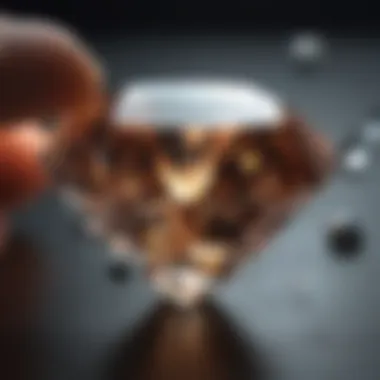
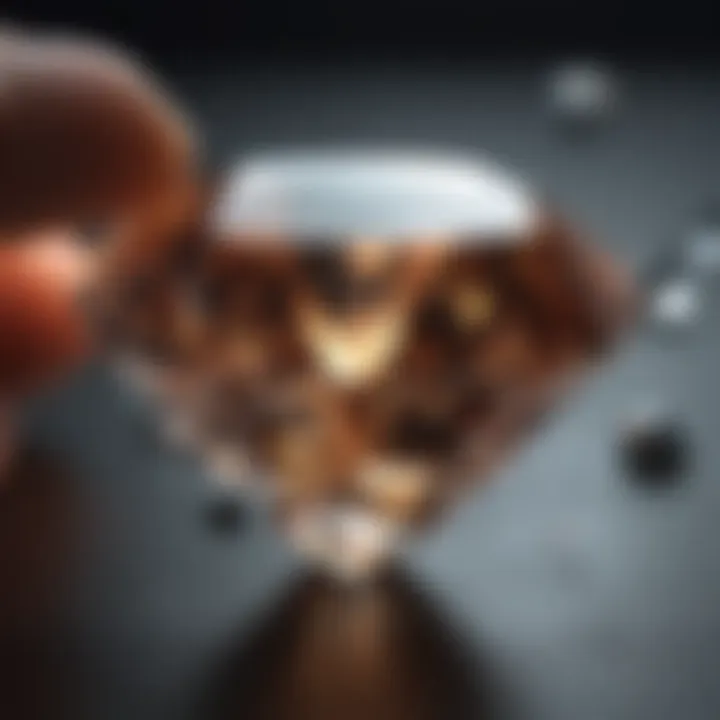
Misidentifying a diamond can have significant repercussions, affecting not only financial interests but also causing emotional distress. Understanding these consequences helps individuals navigate their choices more wisely when dealing with gemstones. This section dives deep into the personal and financial impacts that often stem from a mistake in discerning the authenticity of a diamond.
Emotional Implications
When a person discovers that their supposed diamond is, in fact, an imitation, the emotional fallout can be profound. People frequently invest not just money, but also sentiment into their gemstones. A diamond often symbolizes love and commitment, especially when given as a gift or used in an engagement ring.
The realization that a cherished piece is fake can lead to feelings of betrayal and loss. This emotional rollercoaster also touches on self-esteem, as individuals may feel duped or inadequate for not having recognized the signs of inauthenticity.
Moreover, the association of the diamond with significant life events intensifies these feelings. For example, the diamond meant to celebrate a wedding anniversary or a special milestone suddenly becomes a source of disappointment rather than joy. In essence, the emotional implications of misidentification run deep, showcasing how our connections to such pieces go far beyond their monetary worth.
Financial Ramifications
From a financial standpoint, the ramifications of misidentifying a diamond can be staggering. The diamond market is rife with opportunities for scams, and falling prey to a phony gemstone can lead to considerable monetary loss.
What initially seems like a good deal might translate into throwing money down the drain if the buyer later learns the jewel is just high-quality glass or another imitation.
Investing in diamonds requires due diligence, as prices can range dramatically based on the quality and authenticity of the stone. When buyers mistakenly purchase imitation stones at inflated prices, it can seriously dent their financial plans. Furthermore, in cases where diamonds are intended for resale, a misidentified stone will likely lead to disappointing returns, if not total losses.
"The costs of misidentification don't just stop at the purchase; they're compounded by repair, diminishing resale value, and emotional health."
In some instances, there may be legal ramifications, particularly if the buyer can prove that they were misled. Depending on the circumstances, this could involve lawsuits against sellers, further draining financial resources.
Best Practices for Purchasing Diamonds
Purchasing a diamond is not just a transaction; it's often a significant investment that carries emotional weight. Understanding the best practices for this process is crucial in ensuring that you make an informed decision that aligns with your expectations and budget. These practices help you navigate the intricacies of the diamond marketplace, allowing you to discern quality and authenticity while ultimately safeguarding your investment.
Research and Education
Knowledge is power, especially when diving into the vast ocean of diamonds. One of the best practices you can adopt is to conduct thorough research before stepping into a jewelry store or browsing online. Understanding the 4 Cs—cut, color, clarity, and carat weight—will serve as your compass.
- Cut: This affects the diamond's sparkle and brilliance. Familiarize yourself with different cut grades and shapes.
- Color: Learn about the color grading scale. A diamond's value largely hinges on its color characteristics.
- Clarity: Understand the difference between inclusions and blemishes, and how they impact the visual appeal.
- Carat Weight: Recognize that carat weight influences both the value and the visual size of the diamond.
Utilizing online resources, such as reputable gemological sites and educational videos, can deepen your understanding. Websites like Gemological Institute of America provide valuable insights. Furthermore, forums on platforms like reddit.com can connect you with other gemstone enthusiasts.
"Knowledge is the most powerful tool in making smart purchases."
Finding Reputable Dealers
Once you’ve equipped yourself with knowledge, the next step is to locate trustworthy dealers. The diamond market can have its fair share of wolves in sheep’s clothing. Start by seeking recommendations from friends, family, or even jewelry designers. It also helps to check reviews and ratings on platforms like facebook.com.
Key qualities to look for in a dealer include:
- Transparency: A good dealer should provide ample information about the diamonds, including certificates from gemological laboratories.
- Return Policies: Reliable dealers will have clear return or exchange policies, which can add a layer of security to your purchase.
- Customer Service: Being treated well can be a good indicator of a reputable business. Ask questions and gauge their responses.
Don’t hesitate to visit multiple dealers; this can give you a better sense of the pricing and available options. Building rapport with a dealer can often lead to better deals or insights.
Understanding Certification
When purchasing diamonds, certification is your best friend. A certificate provides an evaluation of the diamond's qualities and is issued by a reputable gemological institute, like the Gemological Institute of America or the International Gemological Institute. Having a certified diamond means you have proof of its authenticity and characteristics.
Key points to check regarding certification include:
- Clarity of Information: Ensure that the details on the certificate are clearly documented and match the diamond being considered.
- Reputable Sources: Only trust certifications from well-established and reputable gemological organizations.
- Value Reference: Certification helps you understand whether the price aligns with the diamond’s quality.
By grounding yourself in these best practices, you reduce the risk of missteps and increase the odds of securing a diamond that meets your needs—both aesthetically and financially.
Final Thoughts
In summary, identifying the authenticity of diamonds is not just for seasoned gemologists or those in the jewelry business. It’s essential knowledge for anyone considering a purchase, whether a lifelong collector or a first-time buyer. This knowledge helps secure both emotional and financial investments, enabling individuals to navigate a market often riddled with misconceptions.
Summarizing Key Points
Understanding the various types of diamonds and their characteristics lays the groundwork for making informed decisions. Here are some crucial takeaways from this article:
- Natural vs. Synthetic Diamonds: It's important to distinguish between naturally formed diamonds and synthetic ones created in labs. While both can be stunning, their values differ significantly.
- Visual Characteristics: Real diamonds exhibit a unique brilliance and fire, which are essential for evaluation. Observing clarity and understanding color grading systems can add depth to your assessment.
- Practical Tests: Conducting simple tests like the water test or fog test can provide initial insights into a diamond's authenticity. These are easy to perform at home, requiring little more than everyday items.
- Advanced Verification Techniques: For those who want to dive deeper, employing professional appraisal services or seeking gemological reports can help ensure you're making a purchase worth your hard-earned money.
- Common Imitations: Being aware of imitations like cubic zirconia or moissanite can protect buyers from making costly mistakes. Familiarizing yourself with these can enhance your purchasing skills.
Encouraging Informed Choices
Every intent to purchase a diamond should be accompanied by research and preparation. This equips you to not only spot imitations but also to appreciate the unique qualities of authentic diamonds. Here are a few tips to cultivate informed choices:
- Educate Yourself: Engage with resources that expand your knowledge base, be it books, articles, or forums like reddit.com where you can meet fellow gem enthusiasts.
- Seek Reputable Dealers: Establish relationships with trustworthy sellers. Whether you’re buying online or in-person, finding a dealer who values transparency and integrity is vital.
- Understand Certifications: Familiarize yourself with what certification means. Reports from organizations like the Gemological Institute of America (GIA) can be invaluable. They ensure the diamond's quality, making the investment more secure.
For final insights, remember that knowledge is your best ally when navigating the diamond market. It enables you to make confident choices that align with your personal values and needs, ensuring that your investment stands the test of time.



